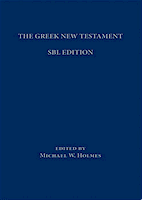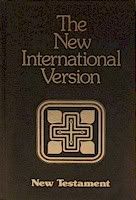 Bible Abbreviation: RSV
Bible Abbreviation: RSVISBN: n/a
Publisher: Thomas Nelson & Sons
Publication Date: 1952
Pages: 1312
Binding: Hardback
Size: 5.75” x 8.5” x 1.75”
Features: This first edition Revised Standard Version is both a readable and a literally accurate translation. The scriptures themselves are presented in two columns with occasional footnotes that cover cross-references, alternative translations, etc.. There is no concordance, dictionary or maps. This is definitely a plain vanilla edition.
Comments and Observations: This revision is a member of the Tyndale family of Bibles. Its lineage can be traced from the American Standard Version of 1901 to the 1611 King James Version back to the various versions which emanated from the work of William Tyndale. One major change from its immediate predecessor, the American Standard Version, is that it translated the tetragrammaton (יהוה - JHVH) as Lord or God. The American Standard Version rendered the Tetragrammaton as Jehovah in over 6,800 locations.
The translation committee used the Nestle-Aland Greek - 17th edition text to translate the New Testament where the King James used the Textus Receptus aka Received Text. The Hebrew Masoretic Text was used for the Old Testament. In one major innovation, the translation committee would occasionally use readings from the then newly discovered Dead Sea Scrolls in its translation of Isaiah.
This version was not without its controversies. Fundamentalists and evangelicals charged that the translators had corrupted the Scriptures so that the doctrine of the Virgin Birth of Jesus was no longer supported in the Old Testament. The heart of the storm was the Hebrew word עַלְמָה (almāh) found in Isaiah 7:14. The RSV translation committee rendered it as young woman instead of the more orthodox translation of virgin so that it no longer agreed with Matthew 1:23.
Another verse also caused some consternation. John 3:16 was shorten from “only begotten son” to “only son”. Genesis 9:20 was poorly translated to say that Noah was “the first tiller of the soil”. This directly conflicts with Genesis 4:2: “Cain was a tiller of the ground.”
Old Testament Comparative Verse: Psalms 23:1-6.
1 The LORD is my shepherd, I shall not want;
2 he makes me lie down in green pastures.
He leads me beside still waters;
3 he restores my soul.
He leads me in paths of righteousness
for his name's sake.
4 Even though I walk through the valley of the shadow of death,
I fear no evil;
for thou art with me;
thy rod and thy staff,
they comfort me.
5 Thou preparest a table before me in the presence of my enemies;
thou anointest my head with oil,
my cup overflows.
6 Surely goodness and mercy shall follow me
all the days of my life;
and I shall dwell in the house of the LORD
for ever.
New Testament Comparative Verse: Matthew 5:1-12.
1 Seeing the crowds, he went up on the mountain, and when he sat down his disciples came to him. 2 And he opened his mouth and taught them, saying:
3 "Blessed are the poor in spirit, for theirs is the kingdom of heaven.
4 "Blessed are those who mourn, for they shall be comforted.
5 "Blessed are the meek, for they shall inherit the earth.
6 "Blessed are those who hunger and thirst for righteousness, for they shall be satisfied.
7 "Blessed are the merciful, for they shall obtain mercy.
8 "Blessed are the pure in heart, for they shall see God.
9 "Blessed are the peacemakers, for they shall be called sons of God.
10 "Blessed are those who are persecuted for righteousness' sake, for theirs is the kingdom of heaven.
11 "Blessed are you when men revile you and persecute you and utter all kinds of evil against you falsely on my account. 12 Rejoice and be glad, for your reward is great in heaven, for so men persecuted the prophets who were before you.
Weaknesses: The KJV uses italics to indicate which words have been added to the text in order to make their translation more readable. The RSV did not follow this practice. Therefore, the reader is not made aware of which words are not part of the original text. For example, in the RSV Habakkuk 1:1 reads, "The oracle of God which Habakkuk the prophet saw." The translators added the phrase “of God”. It is not supported in any ancient text of the Bible, be it Masoretic Hebrew, Dead Sea Scrolls, Greek Septuagint or whatever. Inserting a critical conjecture without notice is not a good practice.
Strengths:
It somehow manages to retain the literary beauty of the King James Version while updating the language to 20th century English. I like reading this version … a lot.



